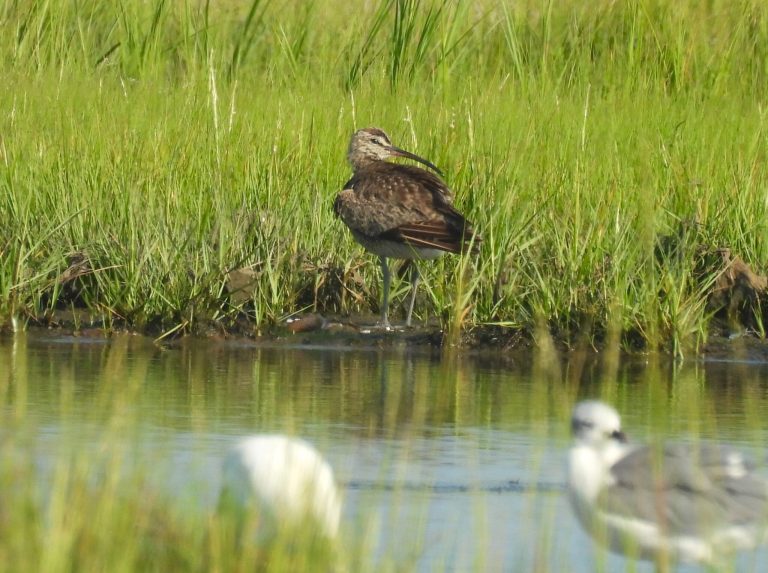
Last week I was excited to be included in a boat tour of the marsh islands in the bay between Freeport and Point Lookout. This trip was organized by South Shore Audubon Society President, Russ Comeau. Russ said the purpose of the trip was to “connect bird club, birding community, and Audubon chapter leaders with their fellow leaders from Long Island, New York City, and the Hudson Valley.”
Responding eagerly to the prospect of seeing the south shore marshes during shorebird migration were leaders from Audubon chapters and birding clubs including the seven Audubon chapters on Long Island, New York City, and Westchester, Rockland, Ulster and Dutchess Counties.
After watching the weather with trepidation all week as Hurricane Debbie wreaked havoc to the south, the remnants passed through overnight, and we were rewarded with a sunny, balmy, calm day.
Though the prospect of a three hour tour had slightly ominous implications, we had smooth sailing with Captain Emily of http://www.SirenSongFreeport.com . The Captain was thrilled to have a group of hard core birders to indulge one of her favorite pastimes. We took a large pontoon boat out from Freeport into the marsh islands.
We had barely cleared the dock before the Captain pointed us to a nesting pair of Black-crowned Night Herons, who opted for a choice location on the roof of a seafood shack where the pickings are easy.
Though these birds are still quite abundant, their numbers have been plummeting and no one knows why, so it was good to see a healthy-looking Heron chick.
A little farther down the channel on a site that had been a restaurant before it was demolished by Super Storm Sandy, a Killdeer family frolicked amid the piles of dirt and concrete. Then we were out into the waterways that snake between the marsh islands.
Great Egrets were the first and most obvious birds as these over 4’ tall white birds’ long slender necks rise above the seagrasses as they hunt for small fish, crabs, frogs and even lizards and mice.
They are grouping in flocks before they start to migrate south. Joining them were the pint-sized Snowy Egrets and a smattering of Great Blue Herons. The Great Blues will stay well into winter until they are forced out by ice along the shorelines.
Foraging in shallow tidal ponds on the marsh islands were a typical variety of migrating shore birds. Least, Semipalmated and Spotted Sandpipers, Sanderlings, Black-bellied and Semipalmated Plovers, Short-billed Dowitchers and three species of Terns were spotted during the voyage.
A wave of excitement ran through the crowd when two Whimbrels were spotted flying over the tops of the marsh grasses. There was even more excitement and jostling for photography positions when another one was seen perched on the bank of a marsh pond, providing good views. These large, brown shorebirds with long, down-curved bills prefer marsh islands, so while not considered rare, are not easy to find.
We also encountered other boaters enjoying the beautiful weather. Some were unfortunately indulging in what Captain Emily gently referred to as “unkind boating.” Several times we had to grab onto a rail as the wake from a speeding vessel rocked the boat. The wakes from those boats also erode the shorelines of the marshes.
The trip was a terrific way of seeing migrating shorebirds, but you don’t have to get on a boat to see the flocks fueling up before long flights south. Lido Preserve, Jones Beach Coast Guard Station and West End, and Nickerson Beach all host large assortments of migrating birds and Nickerson is the preferred nesting site for large colonies of Comon Terns, American Oystercatchers and Black Skimmers all summer long.
Long Island is uniquely situated to attract and support nesting and migrating birds with deep protected marshes and ocean beaches.







